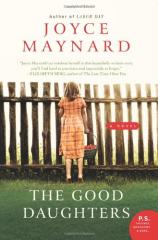The Good Daughters
Review
The Good Daughters
On the strength of novels like LABOR DAY, Joyce Maynard has earned a well-deserved reputation as a keen observer of the intimate spaces of family life. In her new novel, Maynard sticks to that turf to tell a story of two women whose lives intertwine in unanticipated ways over the course of the 20th century’s second half.
Dubbed “birthday sisters,” Ruth Plank and Dana Dickerson are conceived in the midst of Hurricane Bonnie and born in the same New Hampshire hospital on July 4, 1950. Ruth, tall and blond, is the youngest of five daughters of Edwin and Connie, a stolid couple running a farm that has been in the family for 10 generations. While she’s close to her father, Ruth demonstrates only a tolerance for farm life and an early inclination toward art that eventually leads her to her life’s work. For Ruth, Dana “seemed to provide the standard against which my own development and achievements should be measured. And when this happened, I could pretty much rely on falling short, in anything but the height category.”
"Those who have admired Maynard’s previous work likely won’t be disappointed this time around."
Short and stocky Dana is the daughter of George and Valerie. Her father is addicted to get-rich-quick schemes that have him on the road or moving the family from one temporary abode to another during much of Dana’s childhood, while her mother dabbles at art. Despite her family’s nomadic existence, Dana displays an interest in farming that, like Ruth, will end in a career choice. Dana “admired the Plank family’s steadiness and constancy, the order with which their lives unfolded, particularly measured against the untidiness of our own.” Though the Dickersons leave New Hampshire early in the novel, each family engages in a brief annual visit to the other that seems inexplicably absent of any reason for connection other than the accident of the daughters’ common birthdate.
Except for a prologue and one dramatic passage near the end of the book, the story unfolds in the alternating first-person narratives of Ruth and Dana, whose accounts at first run parallel and then move inexorably toward each other. Maynard makes passing mention of some of the major events of American history over the past two generations, but with one exception she avoids turning her protagonists into Forrest Gump-like participants in those milestones. With one of her sisters, Ruth makes her way to Woodstock where she encounters Dana’s older brother, Ray, who has been an object of Ruth’s affection since childhood. When Ray flees to Canada to avoid the Vietnam War draft, Ruth follows him to a remote island off the coast of British Columbia. Their passionate affair and its shocking conclusion is one of the novel’s emotional pivot points.
Maynard also describes with an attentive tenderness the relationship between Dana and her partner Clarice, a professor of art history. The two buy a small farm on the coast of Maine where Dana propagates new strains of strawberries (where the term “good daughters” takes on a special resonance) and raises goats to produce a popular goat cheese. When Clarice becomes ill, Dana looks after her lover in scenes of great tenderness. Apart from chronicling the prejudice the pair confronts as a lesbian couple, the novel is mostly silent on the feminist movement, an odd choice considering Ruth and Dana, both strong, independent women, come of age in the midst of its flourishing.
That Ruth and Dana are both sympathetic characters, albeit with voices that are not particularly distinct, will be enough to keep most readers engaged in the story, though there are times when Maynard’s narrative has a pedestrian quality, as predictable circumstances --- illness, aging, marriage and divorce, economic pressures --- roll through the lives of the Planks and the Dickersons. Perhaps that’s what makes the secret revealed in the novel’s concluding chapters even more startling.
It’s a challenge to suspend one’s disbelief when that secret, linking Ruth and Dana inextricably, is revealed. In that and other moments, THE GOOD DAUGHTERS veers dangerously close to melodrama, always a risk with novels that treat of this subject matter. But even for the skeptics among us, it’s hard to deny there’s a genuine emotional payoff in the book’s climactic scenes. Those who have admired Maynard’s previous work likely won’t be disappointed this time around.
Reviewed by Harvey Freedenberg on January 22, 2011
The Good Daughters
- Publication Date: August 23, 2011
- Genres: Fiction
- Paperback: 304 pages
- Publisher: William Morrow Paperbacks
- ISBN-10: 0061994324
- ISBN-13: 9780061994326









